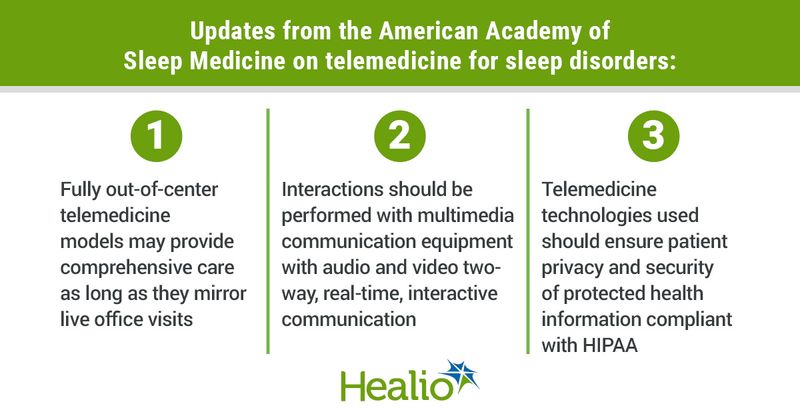American Academy of Sleep Medicine updates guidance on telemedicine for sleep disorders
The American Academy of Sleep Medicine released an update highlighting the benefits of telemedicine during the COVID-19 pandemic for the diagnosis and treatment of sleep disorders.
“The COVID-19 pandemic challenged traditional methods of health care delivery as health systems curtailed nonemergent care at hospitals and sought to provide the safest possible environments for patient care,” Qurratul Afifa Shamim-Uzzaman, MD, MS, assistant professor of internal medicine in the department of neurology at the Sleep Disorders Center at University of Michigan and the Sleep Medicine Sections/Ambulatory Care Service at VA Ann Arbor Healthcare System, and colleagues wrote in the Journal of Clinical Sleep Meedicine. “Telemedicine became the cornerstone of providing health care in an environment that was safe for patients, providers and staff, and health care systems reported dramatically increased rates of telemedicine utilization to manage pandemic-related stay-at-home orders.”

Currently, telehealth follow-up visits, mainly via phone, are used for the chronic management of obstructive sleep apnea, and internet-delivered cognitive behavioral therapy for insomnia has been effective among adolescents. However, telemedicine management has not been studied specifically among other sleep disorders, including restless legs syndrome or parasomnias, although studies suggest managing these sleep disorders via telemedicine may also prove successful.
The American Academy of Sleep Medicine (AASM) reviewed and updated its 2015 position paper in the wake of rising telemedicine use during the COVID-19 pandemic.
One area updated focused on synchronous and asynchronous telemedicine services. Synchronous telemedicine services occur in real time with audio and video communication at a distant site while mirroring live office visits. Asynchronous telemedicine services include remote interpretation of store-and-forward systems, electronic communication, electronic consultations and self-directed care mechanisms and may be separated by distance and time.
The AASM updates for synchronous and asynchronous telemedicine services are as follows:
- Fully out-of-center models may provide comprehensive care as long as they mirror live office visits.
- These interactions should be performed with multimedia communication equipment permitting audio and video two-way, real-time, interactive communication.
- Asynchronous telemedicine services require patient consent and must be obtained at least annually.
- Because asynchronous telemedicine services have become reimbursable due to the COVID-19 pandemic, providers should consult payers regularly to ensure continuous reimbursement for asynchronous services.
Technical requirements for performing telemedicine visits will continue to change as technology continues to evolve. The AASM provided several updates for technology-based requirements, including:
- Any telehealth technology used should ensure patient privacy and security of protected health information compliant with HIPAA.
- Audio-video chat applications used for synchronous telehealth services during the pandemic must limit participation to only intended parties and require HIPAA business associate agreements with the technology vendor to ensure compliance.
- Adherence to federal and state regulations and HIPAA compliance are vital regardless of telemedicine modality used, and providers across state lines are subject to these requirements in all states in which provider and patient are located during clinical encounters, sleep testing and prescription of controlled substances.
The update also highlights the importance of patient and provider safety during telehealth visits. This includes the provider ensuring all data security and encryption protocols are up-to-date and disclosing risks to the patient before enrollment.
“Telemedicine in the home setting puts the onus on the patient (or personal caregiver) to participate in and manage their own health care needs which can impact patient safety,” the authors wrote.
According to authors, because barriers such a physical space and multiple simultaneous patient check-ins are no longer an issue, novel models of care, including shared medical appointments, may be more easily conducted via telemedicine, but it is important to compare clinical outcomes with in-person interactions to assess equivalence or noninferiority.
“More research is needed regarding the impact of telehealth on access to care, health care navigation, resource mobilization and health inequalities to influence health policy and create systemic change. The role of industry and consumer technology in diagnosing and managing sleep medicine should also be examined,” the authors wrote. “We must identify and share successes in telemedicine during the COVID-19 pandemic to secure broader and more flexible policies to support the expanded use of telemedicine in medical care.”

